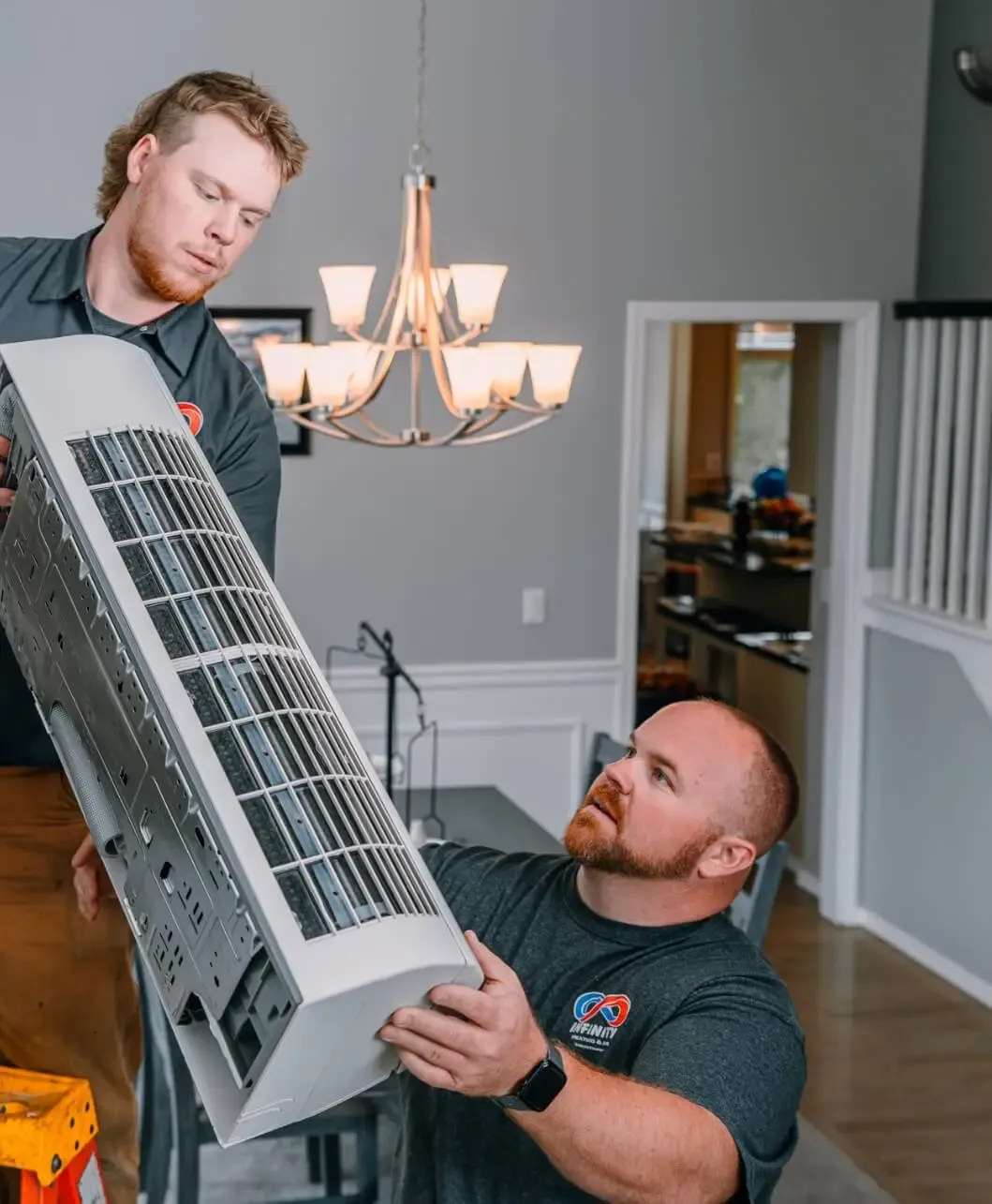
Don’t Get Left in the Cold: Simple Furnace Fixes You Can Do Today
Furnace Troubleshooting: Get expert furnace fixes with Infinity Heating & Air. Solve common issues, find quick checks, and stay warm in 2025!
.webp)

Why Every Northwest Washington Homeowner Needs This Guide
A furnace troubleshooting guide can save you from a cold home on a freezing Northwest Washington morning. Before calling for expensive repairs, there are several simple checks you can do yourself that often solve common heating problems.
Quick Furnace Troubleshooting Steps:
- Check your thermostat – Verify it’s set to “heat” and batteries aren’t dead.
- Inspect the furnace filter – Replace if you can’t see light through it.
- Confirm power supply – Check the furnace switch and circuit breaker.
- Look at vents and registers – Make sure they’re open and unblocked.
- Examine the front panel – Ensure it’s securely closed to engage safety switches.
- Call a professional – If these steps don’t solve the problem.
Many furnace issues are simple, like clogged filters or incorrect thermostat settings. Research shows that dirty air filters are the most common cause of furnace breakdowns, restricting airflow until the system shuts down to prevent overheating.
The good news is most homeowners can handle basic troubleshooting safely. This guide will help you know when to fix it yourself and when it’s time to call Infinity Heating & Air for professional help.
This guide covers quick fixes and safety checks to keep your family warm through Northwest Washington’s challenging winters.
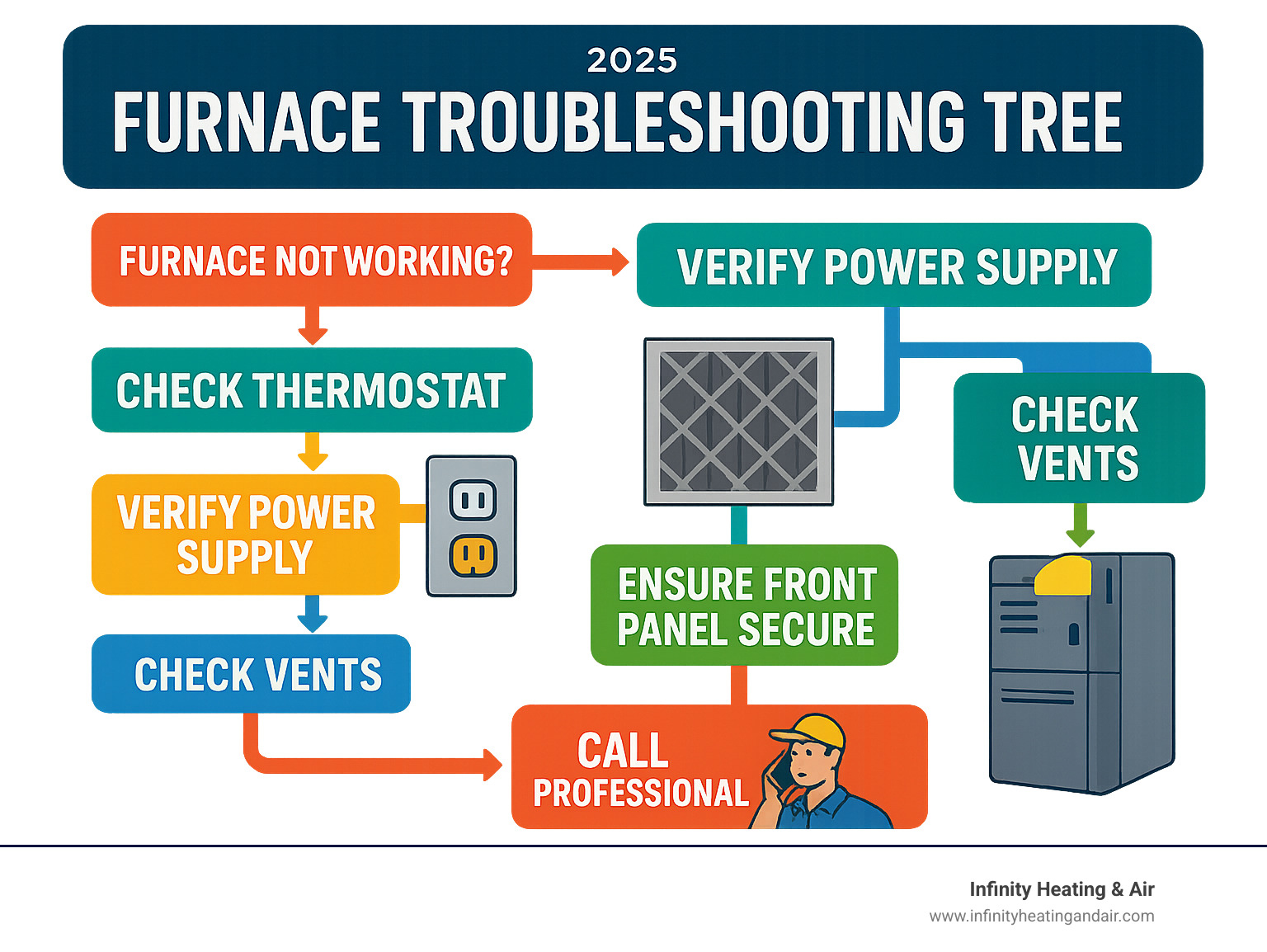
Start Here: Quick Checks for Common Furnace Problems
When your furnace stops, don’t assume the worst. Most furnace problems have simple solutions you can check in minutes. These basic checks solve about 80% of heating issues and can prevent an unnecessary service call. Let’s walk through them.
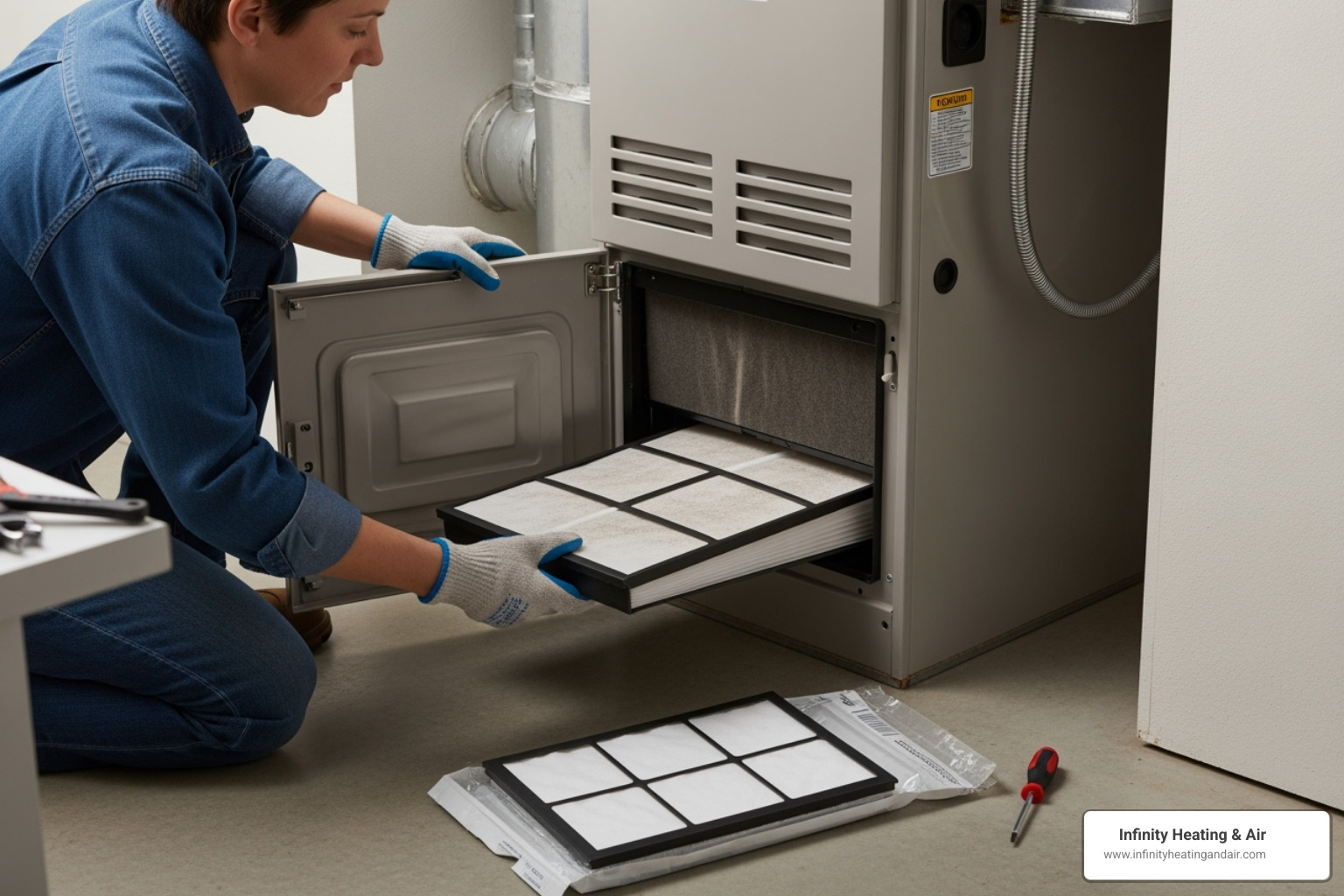
Check Your Thermostat
Your thermostat controls your furnace, making it the first stop in any furnace troubleshooting guide. Ensure it’s set to “Heat” and the temperature is at least five degrees higher than the current room temperature. It’s easy to accidentally switch it to “Cool” or “Off.”
Next, check for dead batteries. If the screen is dim or blank, replace them. For smart thermostats, confirm they are connected to your Wi-Fi network, as the best smart thermostats require an internet connection.
Finally, clean any dust and debris from the thermostat with a soft brush. Also, ensure its readings aren’t affected by nearby heat sources like lamps, sunny windows, or drafts, which can trick it into misreading the room temperature.
Inspect the Furnace Filter
A dirty air filter is the top cause of furnace breakdowns. When the filter is clogged with dust and debris, it creates restricted airflow, causing the system to overheat and shut down for safety.
To check your filter, slide it out and hold it to the light. If you can’t see light through it, replace it. Make sure the airflow direction arrow on the new filter points toward the furnace.
If you have pets or allergies, replace it monthly. Otherwise, every two to three months is typical. Check it regularly during heating season, as different filter types have different lifespans. Regular filter changes, like other home system care, will save you headaches and money.
Verify Power to the Furnace
Many “broken” furnaces simply lack power. First, find the furnace power switch, often on or near the unit, and ensure it’s “On.” It can be accidentally switched off.
Next, check your circuit breaker panel for a tripped breaker labeled for the furnace. To reset it, push it fully to “Off,” then back to “On.” For older homes, check for a blown fuse and replace it with an identical one.
Ensure the front panel door is securely closed. A safety switch cuts power if the door is loose, preventing the furnace from starting.
If a breaker trips repeatedly, it signals a larger electrical problem. Stop resetting it and call a professional.
Your In-Depth Furnace Troubleshooting Guide
Beyond the basics, other issues can prevent your Northwest Washington home from staying cozy. This furnace troubleshooting guide will walk you through the next steps.
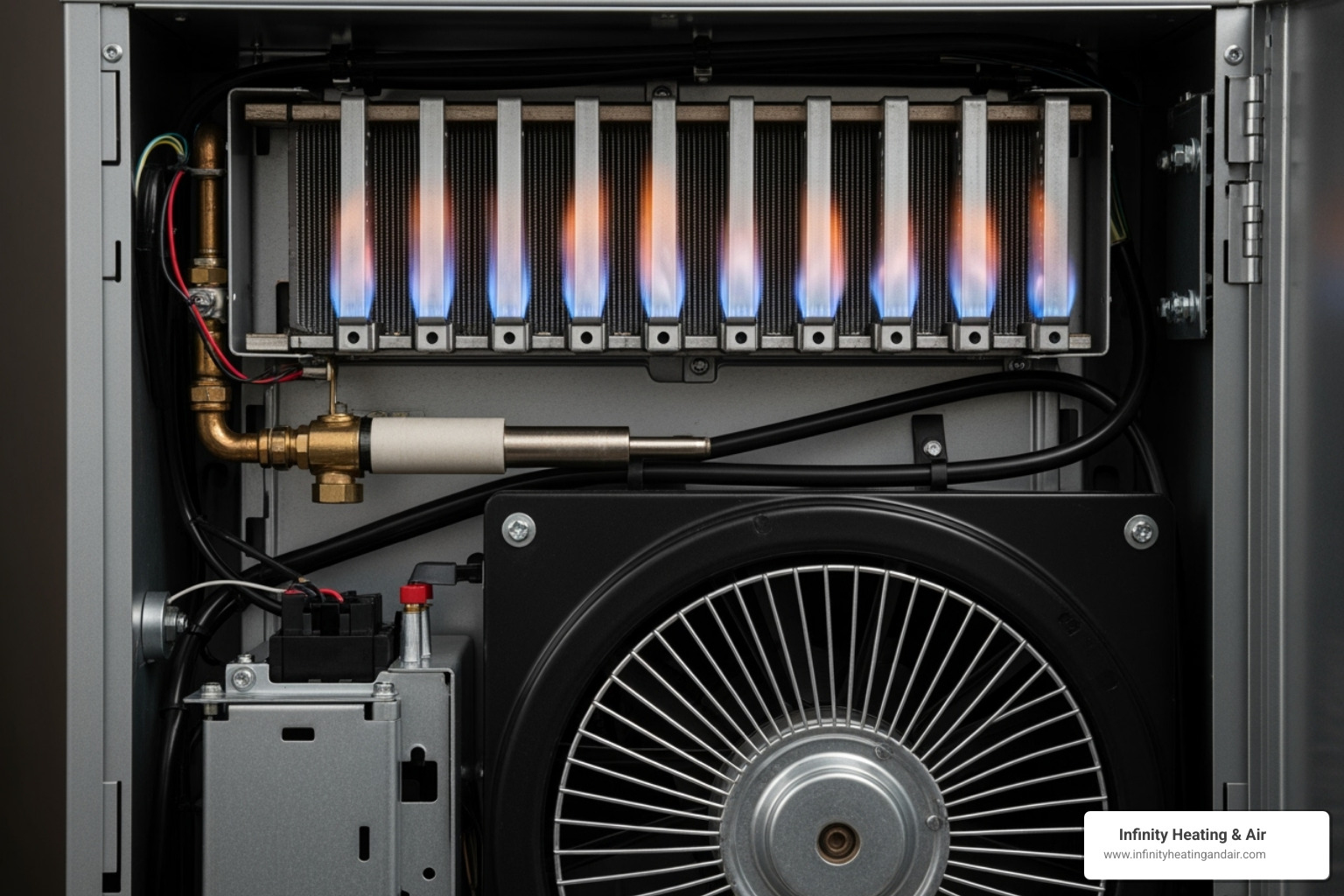
Problem: Furnace Won’t Turn On
If basic power and thermostat checks don’t work, other culprits could be behind a silent furnace.
- Ignition failure: Modern furnaces use an electronic igniter. If it’s dirty, worn out, or has a loose connection, the furnace won’t light. You may hear it try to start, but fail.
- Gas supply problems: For gas furnaces, ensure the gas valve is open (parallel to the line). It may have been turned off during other work.
- Pilot light out: Older furnaces have a standing pilot light that can go out. We cover relighting it in the safety section.
- Hard lockout: This is a safety feature that shuts the furnace down after several failed ignition attempts. You can try resetting it by turning the power off and on. If it locks out again, call Infinity Heating & Air.
Problem: Furnace Runs But Isn’t Heating Enough
If your furnace runs but the house is cold, several issues could be the cause.
- Clogged filters: A dirty filter restricts airflow, preventing warm air from circulating and creating cold spots.
- Blocked vents: Check that all vents and registers are open and unblocked by furniture, rugs, or dust.
- Leaky ductwork: Heated air can escape into walls or crawl spaces. According to duct sealing information from ENERGY STAR, sealing leaks significantly improves comfort and efficiency.
- Blower motor issues: A weak or improperly cycling motor won’t move enough warm air. Frequent on-and-off cycling could point to a problem.
- Incorrect furnace size: An undersized unit will struggle to heat your home, while an oversized one will “short cycle,” leading to poor heating and extra wear.
A Homeowner’s Furnace Troubleshooting Guide for Strange Noises
Unusual noises are your furnace’s way of asking for help. Don’t ignore new or worsening sounds, as they can lead to expensive repairs.
- Whistling: Often indicates an airflow problem, usually from a clogged filter or leaky ducts.
- Banging or popping: At startup, this can mean delayed ignition from dirty burners. Loud bangs could also be from ductwork, but very loud ones may signal duct issues.
- Rattling: Usually means a loose part. Check access panels or listen for debris in the blower wheel.
- Squealing: Often points to a blower motor issue, like a worn belt or bearings. Catching it early can prevent motor failure.
- Buzzing: Suggests an electrical problem, like a faulty transformer or capacitor. Loud or new buzzing requires a professional.
- Clicking: Normal at startup, but continuous clicking could signal an ignition or control board problem.
Safety First: Critical Checks for Gas, Power, and Flames
Safety is the top priority in furnace troubleshooting, especially with gas furnaces. While many issues are DIY-friendly, some require a professional. If you feel unsafe or uncertain, stop and call Infinity Heating & Air. Understanding gas leaks, electrical hazards, and carbon monoxide risks is key to knowing when to call for help.

What to Do if You Smell Gas
A rotten egg smell indicates a potential gas leak and is a genuine emergency. This is the most critical warning in any furnace troubleshooting guide.
If you detect a gas smell, do this immediately:
- Do NOT use light switches, appliances, or any electrical devices.
- Do NOT use your phone inside the house.
- Do NOT light matches or lighters.
- Evacuate everyone from the house immediately.
- Once safely outside, call your gas company and 911.
- Stay outside until emergency personnel say it’s safe to return.
Never attempt to fix a gas leak yourself. Evacuate immediately. For more information, see this guide on how to spot a gas leak.
Understanding Your Furnace Flame
Your furnace flame’s color is a health indicator. A healthy furnace flame is mostly blue, perhaps with a small yellow tip, indicating complete combustion. A yellow, orange, or flickering flame is a warning sign. It indicates incomplete combustion, which can produce deadly, odorless carbon monoxide. This may be caused by dirty burners or a cracked heat exchanger.
If you see an abnormal flame color, turn off the furnace and call a professional. Install carbon monoxide detectors on every level of your home, especially near bedrooms.
Your Guide to Relighting a Pilot Light or Checking an Igniter
The ignition process depends on your furnace type: older models have a standing pilot light, while newer ones use electronic ignition.
For standing pilot lights, first turn the gas valve to “Off” and wait 5-10 minutes for gas to clear. Always follow your manual, but generally, you’ll turn the knob to “Pilot,” press it down, and light the flame. Keep holding the knob for 30-60 seconds for the thermocouple to heat up. If the pilot won’t stay lit, the thermocouple may be faulty. Stop and call a professional, especially if you smell gas.
Newer furnaces use electronic ignition. You should hear clicking when it tries to light. If you hear clicking but see no flame, the igniter may be dirty or failing. You can check for loose wires, but a dirty flame sensor can also be the cause. While you can gently clean the sensor, testing igniters requires electrical knowledge. If you’re uncomfortable with these steps, call Infinity Heating & Air. It’s better to be safe.
Know Your Limits: When to Call for Professional Help
While this furnace troubleshooting guide empowers you to fix common issues, knowing your limits is crucial. Some furnace problems require professional respect.
Call us at Infinity Heating & Air if you encounter any of the following:
- Persistent problems: If you’ve tried all the troubleshooting steps and the issue remains or returns, it could be a symptom of a more complex problem.
- Safety concerns: Any smell of gas, signs of carbon monoxide (headaches, dizziness), or electrical issues mean you should stop and call a professional immediately.
- Complex repairs: Issues with the heat exchanger (cracks can leak carbon monoxide), control board, gas valves, or major electrical parts are too complex for DIY. Attempting these repairs is dangerous and can void your warranty.
- Frequent breakdowns: If your furnace is over 15-20 years old and constantly needs repairs, it may be time for a replacement. We can help you decide.
- Unusual noises: Persistent grinding, screeching, or banging often signals serious mechanical issues that need professional attention before they worsen.
At Infinity Heating & Air, we specialize in designing systems for “endless comfort” and health throughout Northwest Washington. Our trained technicians can diagnose and repair complex furnace problems safely and efficiently. Just as you might call for professional inspection services for other critical home systems, your furnace deserves the same expert care.
There’s no shame in calling for help. We’d rather have you call us for something simple than risk your safety or turn a small problem into an expensive disaster.
Frequently Asked Questions about Furnace Problems
Here are answers to some common questions our furnace troubleshooting guide receives from Northwest Washington homeowners.
What does a blinking light on my furnace mean?
A blinking light on a modern furnace is a diagnostic code. The pattern of blinks corresponds to a specific error. Check your furnace manual for a chart that explains these codes (most manuals are available online). Note the blinking pattern before calling Infinity Heating & Air. This information helps us diagnose the problem faster, sometimes even before we arrive.
What are the main differences in troubleshooting gas vs. oil furnaces?
Gas and oil furnaces share basic checks (thermostat, filter, power), but their fuel systems and ignition differ.
- Fuel Supply: For a gas furnace, check that the gas valve is open. For an oil furnace, check the oil tank level and the oil filter for clogs.
- Ignition: Gas furnaces use a pilot light or electronic igniter. Oil furnaces use an ignition transformer and electrodes to create a spark.
- Maintenance: Gas burners need occasional cleaning. Oil furnace burners have a nozzle that can clog and require more frequent cleaning due to soot.
- Smell: A rotten egg smell indicates a gas leak. A burning oil smell from an oil furnace suggests a combustion problem that needs attention.
How do I troubleshoot a furnace that keeps leaking water?
Water leaking from a furnace often has a simple cause, depending on the furnace type.
- High-efficiency furnaces produce condensation that drains through a line. If this line clogs with debris or ice, water will leak. You can try clearing minor clogs with a wet/dry vac or by pouring vinegar down the line.
- A condensate pump, if your furnace has one, could have failed or its reservoir could be clogged, causing a backup.
- A leak could also come from an attached whole-house humidifier.
- Rarely, a leak from a high-efficiency furnace can indicate a cracked secondary heat exchanger, a serious problem requiring a professional.
- The water might also be from your air conditioner’s overflowing condensate pan, especially in spring or fall.
Always turn off the power before investigating a leak. If you can’t find the source or fix it easily, call us to prevent further damage.
Keep Your Furnace Running Smoothly
The best furnace troubleshooting guide is the one you rarely use. Preventing problems is better than fixing them. Think of it like car care—regular maintenance keeps you from getting stranded.
Annual professional tune-ups are the best way to prevent problems. A technician will clean components, check connections, lubricate parts, and inspect the heat exchanger and safety controls. This proactive approach catches small issues before they become expensive emergencies.
Regular maintenance saves money on energy bills. A well-maintained furnace runs more efficiently, using less fuel. As noted in Why energy efficiency matters, this is also better for the environment.
Between tune-ups, your role is crucial. Changing the air filter regularly and keeping vents clear are the most important things you can do for your furnace’s performance and your home’s air quality.
Cleanliness matters. Dust and dirt are your furnace’s enemies, making it work harder. A clean furnace runs better and lasts longer.
At Infinity Heating & Air, we’re passionate about creating “endless comfort” for families throughout Northwest Washington. We understand that your home should be a refuge from our region’s challenging winters. While we handle all your heating and air quality needs, we also know that comprehensive home maintenance involves many systems working together.
Ready to give your furnace the care it deserves? Contact us for service and let us help you avoid those middle-of-the-night heating emergencies. Your future self will thank you when you’re staying warm and cozy while your neighbors are dealing with furnace breakdowns.

Endless Comfort
Starts Here
Our expert technicians are ready to serve you and your home.





